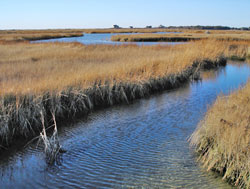 |
 |
 |
|
The Great Sippewissett Salt Marsh
|
|
 |
|
Measuring elevation in an experimental plot
|
Long Term Research in Environmental Biology:
Long-term changes in experimental salt marsh plots: Effects of chronic eutrophication and sea level rise
Field plots in Great Sippewissett salt marsh have been continuously studied since 1970. These plots have provided evidence for many advances in our understanding of the ecology of salt marshes. In particular, we have a continued record of vegetation change in the plots. We plan further field work to synthesize the data record, and to obtain continuing data to examine the separate and joint effects on salt marsh vegetation of two powerful global driving variables, increasing eutrophication, and increasing sea level rise.
The layout of the Great Sippewissett study includes a series of replicated plots that have been fertilized since 1971; replicate plot receive one of 4 doses of fertilizer, and there are replicated control plots that are not treated. Across the many years of work, sea level has risen as much as 14 cm in Cape Cod marshes, including Great Sippewissett: this data set is a real-time experiment in tracing consequences of rise in sea level. Thus, the plots afford an opportunity to examine the interactive long-term effects of eutrophication and sea level rise on salt marsh vegetation and assess the sustainability of New England salt marshes in the face of a continuing combination of eutrophication and sea level rise. The changes we have already seen in marsh vegetation and elevation suggest likely alterations in sediments within the plots. These changes further suggest that the retention of nitrogen and heavy metals, one of the important applied attributes of sediments of coastal wetlands, might also have been altered cross the decades. We 1) use long-term plots in Great Sippewissett to define decadal changes in vegetation in salt marshes chronically exposed to different nitrogen loads and to sea level rise, and to quantify the separate and joint effects of these two agents of ecological change on long-term patterns of composition and spatial mosaics of salt marsh vegetation; 2) assess long-term retention and storage of externally supplied nitrogen and metals in salt marsh sediments under different N loading regimes and sea level rise.
The merit of these studies is to answer several basic questions about long-term adjustments in structure of salt marsh ecosystems under different nutrient loads and changing sea level, as well as to provide information useful to managers concerned with the conservation and use of salt marshes. Specifically, we map cover and biomass of vegetation in the plots by two confirming methods, and assess biomass. These data, manipulated in a GIS framework, let us examine the major question how species composition (cover, biomass, spatial mosaic, and species richness) of the sward responds in the long term to chronic exposure to different rates of limiting nutrient supply, as well as assess how the driving variables alter competitive interactions among marsh plants, spatial structure, and reset community structure. We determine the elevation changes in each plot, and relate these changes in elevation to spatially-explicit changes in the vegetation on the plots. These data ascertain the linkage of vegetation change to sea level forcing, and quantify the possible interaction with increased nutrient supply provided by the different doses of fertilizer. We assess nitrogen retention by seasonally sampled mass balance measurements in ebb and flood waters, and by detailed study of N content and isotopic N signatures in vertical profiles of sediments measured in cores taken from each plot. Similarly, we assess metal retention by measurement of metal content within vertical profiles and accretion of layers, compared to inputs provided by the treatments with sewage-based fertilizers.
The broader impact of these studies is to furnish new knowledge about basic interactions that restructure salt marsh vegetation and alter underlying sediment profiles, as well as provide data useful to understand how these valuable coastal environments are likely to be altered by the widespread effects of globally increasing eutrophication and accelerated sea level rise.
|
